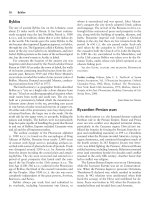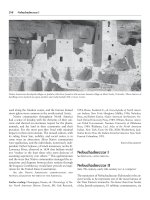Encyclopedia of world history (facts on file library of world history) 7 volume set ( PDFDrive ) 1598
Bạn đang xem bản rút gọn của tài liệu. Xem và tải ngay bản đầy đủ của tài liệu tại đây (64.94 KB, 1 trang )
388
Tordesillas, Treaty of
viceroy was to strengthen and unify the colonial state
under a grand design intended to consolidate Spanish
rule and lay the foundations for continuing Spanish
domination of the Andes and its native inhabitants.
Distinguished Heritage
Born in Andalusia, Spain, around 1520, Toledo hailed
from one of the country’s most distinguished noble
families. After effectively serving Charles V and
Philip II, he was selected as viceroy (supreme administrator and direct representative of the king) of the
newly conquered territories of New Castile (Peru).
One of his first acts as viceroy was to launch a bold
five-year visita, or tour of inspection, of all the Andean
dominions subjugated by Spain.
Accompanied by the pomp and majesty appropriate
to his office, Toledo undertook a census of the entire
colony; ordered the reducción (forced resettlement)
of surviving Indian communities into Spanish-style
towns under the rule of Spanish and native authorities;
directed the collection of testimonies on the injustice
and tyranny of Inca rule with the intention of ratifying the morality of the Spanish invasion and conquest;
abolished the Inca system of mita labor in the Andean highlands and in its stead imposed a new and
even more onerous system of obligatory native labor
and tribute; reorganized and streamlined the territory’s
bureaucracy and administration; revitalized the emergent mining economy, particularly the vast silver mines
of Potosí and the mercury mines of Huancavelica; and
issued a vast corpus of laws and decrees that effectively
limited the autonomy of colonial officials, encomenderos, and other elites while linking their fortunes ever
more tightly to the well-being of the colonial state.
Intolerant of dissent or sustained challenge to Spanish rule, he also directed the invasion and destruction of
the neo-Inca state of Vilcabamba, hidden for decades in
one of the remotest and most inaccessible corners of the
eastern highlands. His decision to execute by beheading
the kingdom’s captured ruler, Tupac Amaru, a sentence
carried out on September 24, 1572, in Cuzco, remains
among his most controversial actions, even prompting
a mild rebuke from King Philip, who declared in a letter
to Toledo that “some things about the execution would
have been better omitted.”
All of these and related measures, commonly
referred to as the Toledo reforms, had the effect of
centralizing and strengthening the colonial state and
laying the groundwork for a mature colonial economy
and society that for the next two and a half centuries
would ensure Spanish domination and funnel untold
riches into Spain, thus marking Toledo as one of the
most important actors in all of Peruvian history. In
1581, at the conclusion of his tenure as viceroy, Toledo
returned to Spain. He died in Seville three years later.
See also encomienda in Spanish America; Peru, conquest of; Peru, Viceroyalty of.
Further reading: Hemming, John. The Conquest of the Incas.
New York: Harcourt Brace Jovanovich, 1970; Stern, Steve
J. Peru’s Indian Peoples and the Challenge of Spanish Conquest: Huamanga to 1640. Madison: University of Wisconsin Press, 1982; Zimmerman, Arthur Franklin. Francisco de
Toledo: Fifth Viceroy of Peru 1566–1881. Caldwell, ID: The
Caxton Printers, Ltd., 1938.
Michael J. Schroeder
Tordesillas, Treaty of
A modification of the papal Bull of Demarcation
issued in 1493 by Pope Alexander VI, the Treaty of
Tordesillas (June 7, 1494) divided the recently discovered New World between its two signatories, Spain and
Portugal. The treaty created an imaginary pole-to-pole
meridian in the Atlantic Ocean 370 leagues west of the
Cape Verde Islands, granting all lands west of the demarcation line to Spain, and all lands east of it to Portugal.
In this era of uncertain geographic knowledge, both
sides recognized that the division was imprecise and
unlikely to prevent future conflict. Spain reckoned that
the newly discovered Indies (Caribbean) fell well within
its sphere of dominion, while Portugal was mainly interested in securing its sea route to Asia around Africa’s
Cape of Good Hope.
Notably, the treaty was concluded six years before
the Portuguese, under Pedro Álvares Cabral, discovered Brazil (1500), though once Brazil was on the
map, there was little doubt that the land fell under
Portugal’s jurisdiction.
Thornier problems arose once it became clear that
the Indies (Americas) lay between Europe and Asia, a
fact that became clear after Portuguese navigator Vasco
de Gama’s journey to India and back in 1497–99,
Spanish explorer Vasco Núñez de Balboa’s discovery
of the Pacific Ocean in 1513, and Portuguese navigator
Ferdinand Magellan’s journey to the Pacific around
the southern tip of South America in 1520 in the service of Spain. In the wake of these advances in Europe’s
knowledge, Portugal refused to abide by a treaty that
essentially granted all of Asia to its Iberian rival.









